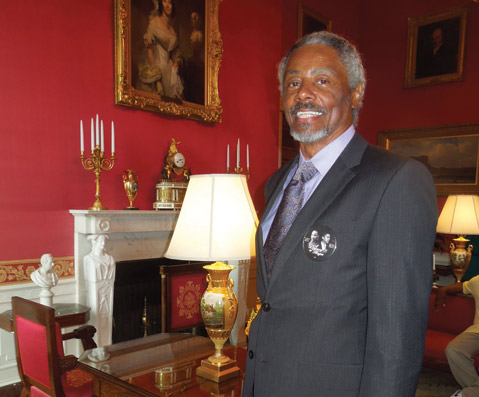S.B. Footballer Gets Presidential Honor
Otto Stowe and 1973 Miami Dolphins Get Nod from Obama

The 1972 Miami Dolphins had been waiting 41 years for the moment, and when it arrived on August 20, they were instructed, “Tall guys get in back.”
“We all bent down,” Otto Stowe said, but he could not fool anybody. The 6’2″ wide receiver was one of the taller members of the team that put together a matchless 17-0 record, capped by a 14-7 victory over the Washington Redskins in Super Bowl VII in 1973. So Stowe went to the top of the three-level riser in the East Room of the White House.
Then Barack Obama entered the room with Don Shula, the team’s coach in that perfect season, and the Dolphins received a public tribute from the president of the United States.
“It’s something I’ve always dreamed of,” said Stowe, a longtime Goleta resident, who made the trip to the nation’s capital with his wife, Judie Stowe. During the players’ private meet-and-greet with the president before the ceremony, Stowe told him he was born in Chicago and grew up in Springfield, Illinois. Obama’s response: “Hey, you’re my homey.”
Stowe was one of 31 players at the ceremony. Three teammates refused to attend for political reasons, even though team owner Stephen Ross, a staunch Republican, paid for the trip and expressed gratitude to the president.
White House invitations have become commonplace for sports champions — UCSB’s 2006 soccer team was welcomed by President George W. Bush — but at the time of Miami’s success, Richard Nixon occupied the oval office, and the Watergate scandal was brewing. Also, Stowe pointed out, “Nixon was an ardent Redskins fan.”
As a football team, the Dolphins were a conservative bunch, which is why current NFL fans may not have heard of Otto Stowe or even Paul Warfield, their Hall of Fame receiver. “Paul was totally awesome, but our game wasn’t throwing the football,” Stowe said. “It was pounding the line with Larry Csonka [a battering-ram fullback] and Mercury Morris. We threw 10 or 12 passes a game.”
Stowe was drafted out of Iowa State in 1971. Miami went to the Super Bowl in his rookie year but lost to the Dallas Cowboys. “The next year, [Shula] was hollering in our ears,” he said. “If he didn’t like the way we practiced, he’d make us do three a day. After the eighth game, we knew we had a chance to make history.”
Warfield took Stowe under his wing. “He didn’t just think of himself,” Stowe said. “Shula told him he’d have to teach me.” It paid off when Warfield was hurt and couldn’t play in the 11th game of the perfect season. In his place, Stowe caught six passes for 140 yards and two touchdowns in Miami’s 31-10 victory over the St. Louis Cardinals.
The Cowboys traded for Stowe the next year and installed him as a starter. He was their leading receiver after seven games when an injury ended his season. He played one more year with the Denver Broncos. He spent the next several seasons on coaching staffs at Iowa State and Washington State. Then he looked to take care of some unfinished business — getting a college degree. That brought him to UCSB.
“Otto wanted a school without a football team so he wouldn’t be distracted,” said Judie. She and Otto went to the same high school in Springfield and have been married more than 40 years — the last 35 in the Santa Barbara area since Stowe earned his BA in ergonomics and health studies.
Stowe, 64, has emerged from pro football in better shape than most former players. He attributes his fitness to his diet — he was been a vegetarian since 1978 — and his practice of yoga. “I’d like to see more athletes get alternative, homeopathic care,” he said.
He had his share of football injuries, including concussions. “It’s impossible not to get one,” he said. But he was not a plaintiff in the lawsuit that resulted last week in the NFL’s agreeing to pay $765 million to compensate brain-injured former players and support research into treatment and prevention.
Could he imagine himself playing in the NFL today? “I couldn’t imagine myself out there when I was out there,” Stowe said. “I thought I’d be a basketball player. I was a center in high school because I was the only guy who could dunk. But I wasn’t tall enough to play center in college.”
So he played football, and he stood tall with the Miami Dolphins in the White House. He wore an Obama/Martin Luther King button on his lapel. Even while being recognized for his part in making football history, Otto Stowe realized that a much more profound moment in history — the 50th anniversary of the “I Have a Dream” speech — would be celebrated a few days later.



